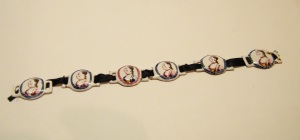The Flint Cottage collection contains a series of rings, each one has it’s own individual story providing an in depth look into the rich tapestry of British history through these small objects:
First, I will focus on the Royalist ring featuring a miniature portrait of King Charles II.

Civil War ring featuring the ghostly image of King Charles II
The ring is gold and features the glazed miniature portrait set between two rose cut diamonds. The ring dates from the 17th century and was worn by a supporter of the Royalist side in the English Civil War. Another property which has a historical link to the Civil War is Ham House in Richmond which you can discover on the website http://www.nationaltrust.org.uk/hamhouse/.
The next three rings in the collection are 18th century mourning rings. Mourning rings were worn to comemorate the memory of a loved one often depicting an image of the deceased, an inspiring motto or even a lock of hair.
The first one in the trilogy of mourning rings is a gold and enamel ring set with two diamonds and what appears to be hair weaved in the background. The picture depicts a skull and two initals, probably belonging to the deceased loved one.

Mourning ring featuring skull image.
Another mourning ring is more decorative and features a miniature of a funeral urn and is set with a border of 25 small rubies. On the reverse of this ring there is an inscription with the date 1775, aged 32.


















